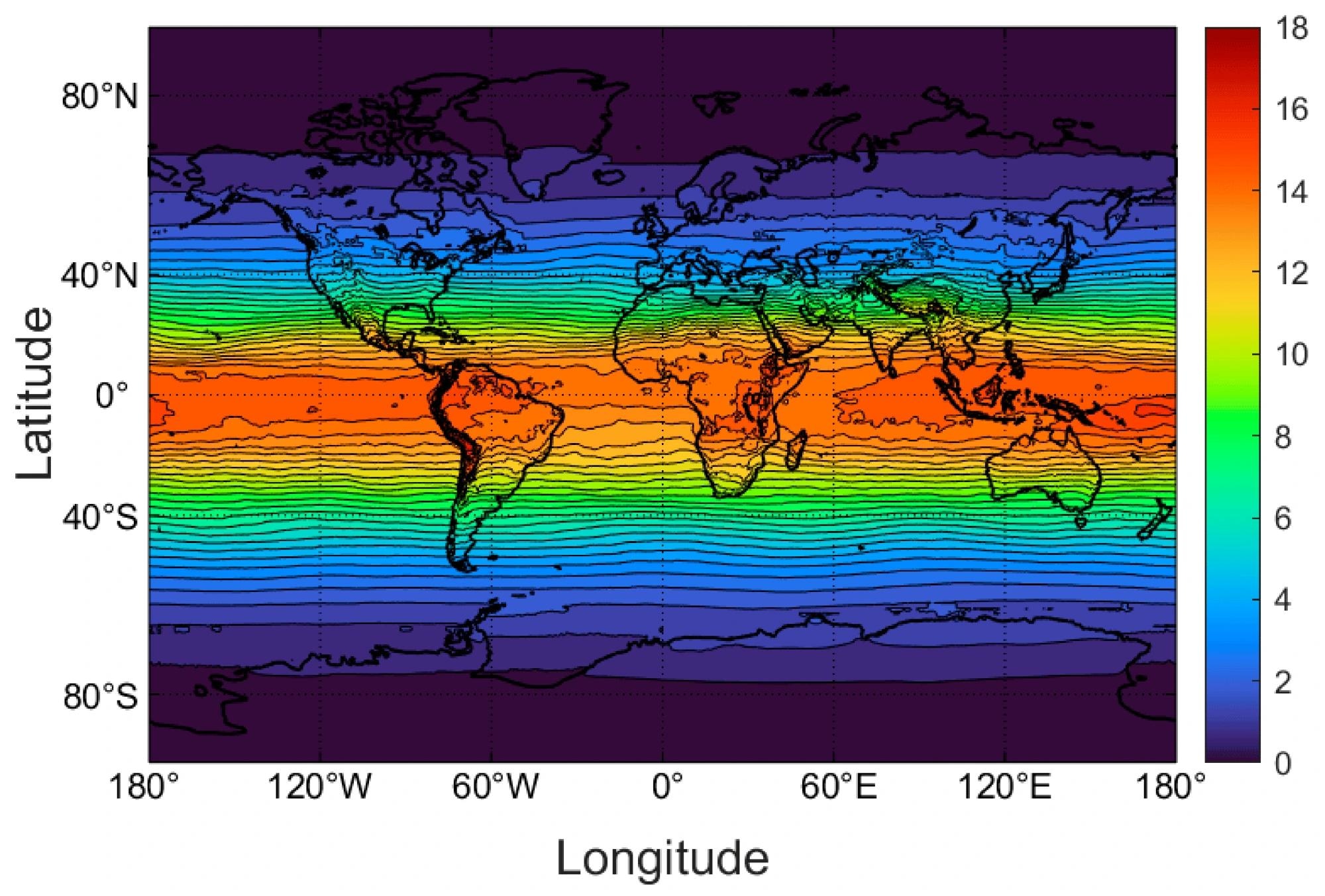The study underscores the importance of personalized approaches to assessing nutritional needs. It highlights the interplay between oral intake, sunlight exposure, and geographical factors, which can inform strategies for addressing widespread vitamin D deficiencies across diverse populations.
 Midday mean clear-sky UVI values averaged over the days of March 2004–2020. While generally latitude-dependent, the UVI is also influenced by column ozone (less in the Southern Hemisphere, especially at high latitudes) and altitude (most noticeable with the Andes on the west coast of South America). Study: Globally Estimated UVB Exposure Times Required to Maintain Sufficiency in Vitamin D Levels
Midday mean clear-sky UVI values averaged over the days of March 2004–2020. While generally latitude-dependent, the UVI is also influenced by column ozone (less in the Southern Hemisphere, especially at high latitudes) and altitude (most noticeable with the Andes on the west coast of South America). Study: Globally Estimated UVB Exposure Times Required to Maintain Sufficiency in Vitamin D Levels
Background
Vitamin D is crucial for musculoskeletal health and has various other health benefits, but deficiencies are prevalent, partly due to inadequate dietary sources and limited sunlight exposure. Public health strategies often involve food fortification or supplementation, yet the challenge lies in balancing vitamin D synthesis with the risks of excessive sun exposure.
About the study
The study aims to provide nuanced guidance by considering factors like latitude, skin type, and time of year to inform national policies regarding food fortification, supplementation, and sun exposure. Thus, it addresses the complexity of maintaining optimal vitamin D levels while minimizing health risks.
Researchers utilized global surface ultraviolet (UV) irradiance data obtained from the Global Ozone Monitoring Experiment (GOME). This data was initially quantified as the UV index (UVI) and later converted to Vitamin D effective UV irradiance.
These data were sourced from instruments attached to European Space Agency (ESA) satellites, providing continuous coverage from 2002 to the present via the TEMIS portal. The study focused on clear-sky UVI and all-sky data, incorporating cloud data where available, to determine UV levels.
To estimate the change in vitamin D status, the study employed calculations from a previous study, which relates exposure to UV in terms of standard vitamin D dose (SDD) to the change in circulating 25-hydroxyvitamin D (25OHD) levels.
The study considered one month for analysis. Initially, a simplified scenario of full-body exposure at noon under clear skies was assessed to calculate the dose required to maintain vitamin D levels.
The analysis involved several adjustments to this baseline calculation, including considerations for skin surface area, skin type (ranging from I to VI with higher numbers indicating darker skin), orientation, and potential variations in UV exposure due to clouds.
These adjustments were made to provide more realistic and applicable exposure times for different scenarios, such as standing upright and wearing modest clothing. Additionally, corrections were applied for darker skin types at higher latitudes and seasonal variations in UV levels due to clouds.
Overall, the methodology aimed to provide tailored exposure recommendations, considering various environmental and personal factors that affect vitamin D synthesis.
Findings
The analysis revealed distinct exposure times required for maintaining vitamin D levels under clear-sky and cloudy-sky conditions.
Under clear skies, exposure times for white skin types ranged from 3 to 15 minutes at every 10 degrees of latitude, with longer durations needed at higher latitudes due to lower sun angles and Antarctic ozone depletion.
Skin type V individuals required increased exposure times at all latitudes compared to skin types I–IV, while skin type VI individuals faced even longer exposure times, especially at higher latitudes.
In contrast, under cloudy skies, the impact of cloud cover varied across latitudes and seasons, extending exposure times by about 15% in equatorial regions and up to an additional 60% at high latitudes.
Despite this, maintenance doses remained achievable for white skin types, even at high latitudes outside the Vitamin D Winter period. However, for skin type VI individuals, exposure times exceeding 15 minutes in equatorial regions and well over an hour at higher latitudes were necessary under all-sky conditions.
Overall, the study underscores the complex interplay between environmental factors, skin type, and UV exposure in maintaining vitamin D levels, highlighting the need for personalized recommendations to account for diverse population needs and local climatic conditions.
Conclusions
The results of this study highlight the importance of balancing oral intake with cutaneous synthesis of vitamin D, particularly through sunlight exposure, to address deficiency effectively. They also provide valuable insights into the feasibility of maintaining vitamin D levels through sun exposure, considering latitude and skin type variations.
Maintaining vitamin D status is challenging during winter due to reduced sunlight availability, especially at higher latitudes. This underscores the need for alternative strategies such as increased sun exposure during summer months or dietary supplementation. Changing lifestyles and occupational habits may impact vitamin D synthesis, particularly for individuals with deeply pigmented skin at higher latitudes.
The study's strengths include its comprehensive approach, which provides guidance on sun exposure durations for different skin types and latitudes. However, limitations such as assumptions about skin area exposure and lack of consideration for cultural practices are acknowledged.
Future research could explore additional factors influencing vitamin D synthesis, such as age and ethnicity, and refine exposure recommendations based on a more nuanced understanding of individual needs and behaviors. Overall, the study's findings contribute valuable insights to guide public health strategies for addressing vitamin D deficiency worldwide.